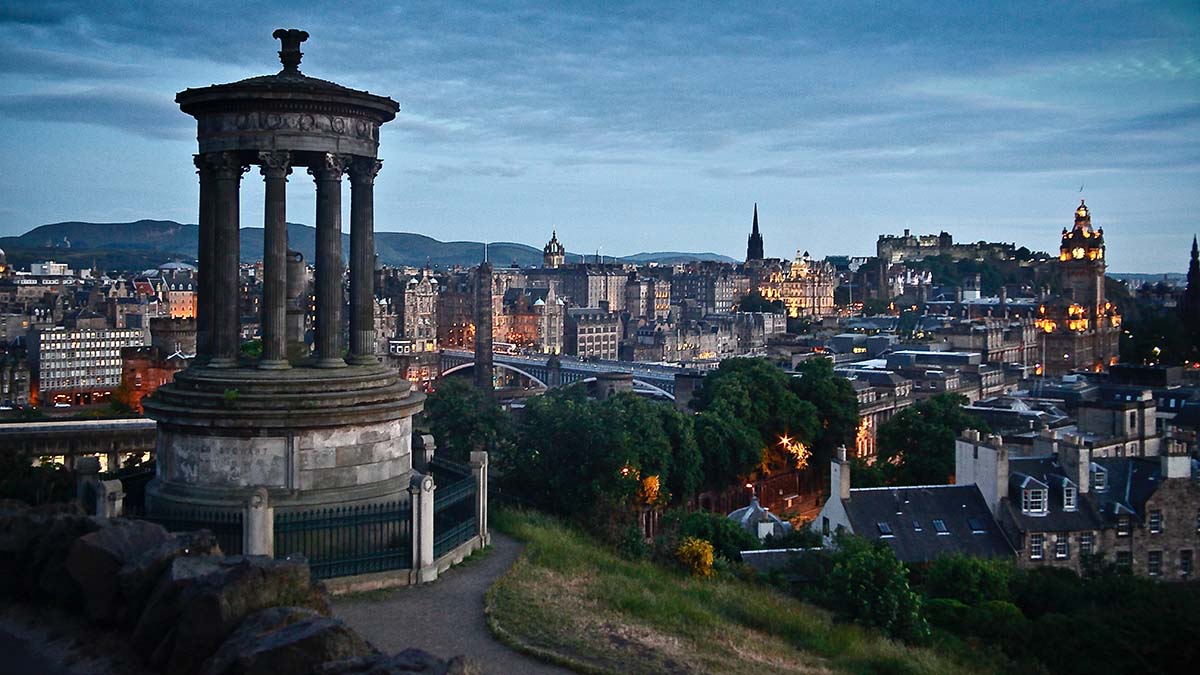
Peeking Under Under Its Kilt
by Tristan Cano
We were rendered almost speechless by the smiling “Guid morning – hou’s it gaun” that greeted us as we negotiated our way towards the baggage carousels at Edinburgh Airport. Its not that immigration officers are famously dour or bad humoured. The quirky provincial accent triggered our realisation that we were very much to the north of Hadrian’s Wall and not in some regional airport in northern England. We were soon to find that this cheerful welcome was to be a common feature among all whom we met on our visit to the Scottish capital.
Edinburgh’s Airport is just a 25 minute taxi ride from Auld Reekie, as the city is affectionately termed by its inhabitants. However a regular and efficient bus service takes just as long and appeals to those supposedly parsimonious Scots, trekking the scenic journey into the heart of Edinburgh’s historic centre for a mere £3.00. On arrival, one is at once taken aback by the city’s many cobbled streets and how they complement the predominately grey granite buildings which themselves are a distinct mix of Georgian and Victorian architecture. Edinburgh’s avenues are lined with historic and listed buildings and losing yourself down the delightful wynds and tunnels leading from streets above to those below is undoubtedly one of the most attractive features of the Old Town. Edinburgh’s skyline has remained virtually unchanged in the last 200 years and belies a city which currently boasts over half a million inhabitants.
 The Royal Mile which leads from the Palace of Holyroodhouse to Edinburgh Castle at its summit is undoubtedly Edinburgh’s most famous thoroughfare. Holyrood Palace, as it is known, is the Queen’s summer home and the Royal Standard flying from the palace roof denotes that she is in residence. Opposite and in stark contrast to the Palace is the controversial Scottish Parliament Building, designed by eccentric Catalan architect Enric Miralles. The original £40 million budget for this structure had grown to a startling £420 by the time it was completed in 2004 but is one of the most spectacular modernist and abstract buildings in the world.
The Royal Mile which leads from the Palace of Holyroodhouse to Edinburgh Castle at its summit is undoubtedly Edinburgh’s most famous thoroughfare. Holyrood Palace, as it is known, is the Queen’s summer home and the Royal Standard flying from the palace roof denotes that she is in residence. Opposite and in stark contrast to the Palace is the controversial Scottish Parliament Building, designed by eccentric Catalan architect Enric Miralles. The original £40 million budget for this structure had grown to a startling £420 by the time it was completed in 2004 but is one of the most spectacular modernist and abstract buildings in the world.
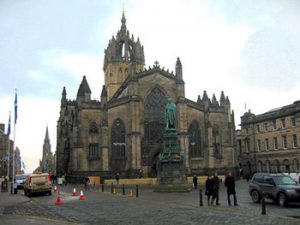 St Giles Cathedral, standing on Parliament Square is arguably the most impressive of several religious buildings on the Royal Mile and visitors will note a heart-shaped mosaic on the pavement near the Cathedral’s west entrance. The Heart of Midlothian records the position of where Toolbooth prison once was and spitting on it supposedly brings good luck.
St Giles Cathedral, standing on Parliament Square is arguably the most impressive of several religious buildings on the Royal Mile and visitors will note a heart-shaped mosaic on the pavement near the Cathedral’s west entrance. The Heart of Midlothian records the position of where Toolbooth prison once was and spitting on it supposedly brings good luck.
Edinburgh Castle itself is the jewel in Edinburgh’s crown. Positioned as it is, at the highest point of the Royal Mile, on the edge of an extinct volcano, it provides superb panoramic views of the city of Edinburgh from its impressive 16th-century battlements. Some parts of the Castle are even older and St Margaret’s Chapel, which dates back to the 12th-century, was dedicated to the wife of King Malcolm III who was himself immortalised in Shakespeare’s Macbeth. The Castle also hosts the world famous Edinburgh Military Tattoo in August of each year which is the largest event of its kind worldwide. Another equally spectacular vantage point is Arthur’s Seat, another extinct volcano just south of the city centre. The walk to the top takes about 45 minutes and is likely to be fairly windswept (to say the least) but you will be rewarded with some awe-inspiring views for your efforts.
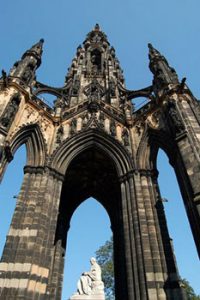 Walking through the Royal Mile it is hard to believe that Edinburgh is in many ways a modern, cosmopolitan city. Princes Street Gardens marks the divide between the Old Town and the neo-classical streets and squares which make up the New Town area. The Gardens are in fact a large public park offering refuge from the hustle and bustle of the surrounding streets. Edinburgh has a rich literary heritage and the neo-gothic Scott Monument which marks the entrance to the Gardens is the largest monument ever built in memory of a writer. Sir Walter Scott is not the only Edinburgh-born writer of repute: Robert Louis Stevenson, Sir Arthur Conan-Doyle and more recently Irvine Welsh (of Trainspotting fame) were all born in the Scottish capital. The National Gallery Complex, also on Princes Street, houses undoubtedly one of the most spectacular art collections in the world and, like its English counterpart in London, admission is free.
Walking through the Royal Mile it is hard to believe that Edinburgh is in many ways a modern, cosmopolitan city. Princes Street Gardens marks the divide between the Old Town and the neo-classical streets and squares which make up the New Town area. The Gardens are in fact a large public park offering refuge from the hustle and bustle of the surrounding streets. Edinburgh has a rich literary heritage and the neo-gothic Scott Monument which marks the entrance to the Gardens is the largest monument ever built in memory of a writer. Sir Walter Scott is not the only Edinburgh-born writer of repute: Robert Louis Stevenson, Sir Arthur Conan-Doyle and more recently Irvine Welsh (of Trainspotting fame) were all born in the Scottish capital. The National Gallery Complex, also on Princes Street, houses undoubtedly one of the most spectacular art collections in the world and, like its English counterpart in London, admission is free.
Edinburgh has a worldwide reputation for its thriving and dynamic arts scene which comes to a head in August each year when millions of visitors converge on the city to enjoy the International and ‘Fringe’ Festivals. The original Edinburgh Festival consists mainly of classical and contemporary arts but is now eclipsed by the ‘Fringe’, which is famous for its theatre and comic offerings and is the largest arts festival in the world. Besides the Hogmanay celebrations (that’s New Year to you and me) the Festival is arguably one of the best times of the year to visit Edinburgh. However if you do choose to visit at these times, not only should you book your accommodation and other tickets well in advance but you should also expect to pay premium prices.
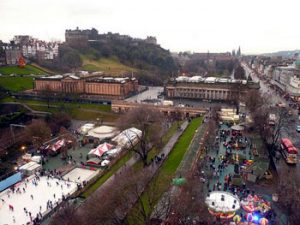 While there is probably no better place than Edinburgh’s Old Town to purchase a kilt, a sporran or indeed tartan fabric by the yard, the New Town contains the city’s main shopping area. The network of roads between Queen and Princes Street also doubles as the hub of Edinburgh’s bar and restaurant district with many of the more upmarket shops, restaurants and bars along George Street and Multrees Walk where you can find the high-end fashion boutiques. Edinburgh is a Mecca for whiskey enthusiasts and the Scotch Whisky Heritage Centre on the Royal Mile is a great place for lovers of the amber nectar to start their evening ‘on the tiles’. But be sure to line your stomach first; as well as the usual ‘tourist-traps’ there are also plenty of establishments in the Old Town specialising in high quality traditional Scottish fare. Modern Scottish cuisine of the less glamorous ‘everything deep-fried’ variety is also well-worth a taste, with a ‘fish supper’ being the perfect choice for the less adventurous (or health conscious) visitor.
While there is probably no better place than Edinburgh’s Old Town to purchase a kilt, a sporran or indeed tartan fabric by the yard, the New Town contains the city’s main shopping area. The network of roads between Queen and Princes Street also doubles as the hub of Edinburgh’s bar and restaurant district with many of the more upmarket shops, restaurants and bars along George Street and Multrees Walk where you can find the high-end fashion boutiques. Edinburgh is a Mecca for whiskey enthusiasts and the Scotch Whisky Heritage Centre on the Royal Mile is a great place for lovers of the amber nectar to start their evening ‘on the tiles’. But be sure to line your stomach first; as well as the usual ‘tourist-traps’ there are also plenty of establishments in the Old Town specialising in high quality traditional Scottish fare. Modern Scottish cuisine of the less glamorous ‘everything deep-fried’ variety is also well-worth a taste, with a ‘fish supper’ being the perfect choice for the less adventurous (or health conscious) visitor.
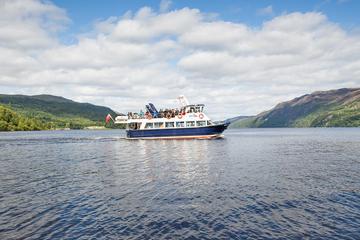
Loch Ness, Highlands and Whisky Distillery Day Tour from Edinburgh
If You Go:
How to Reach Edinburgh:
By Road: You can drive to Edinburgh on the A1 from Newcastle (England), although the fastest route from London involves taking the M1 motorway until this becomes the A1. The journey is approximately 400 miles and will take about 8 hrs.
By Train: Edinburgh’s main railway station is the beautiful Waverley Railway Station which was first opened in 1846. It is located close to Princes Street, Edinburgh Castle and the Princes Street Gardens and is the central hub of the Scottish railway network which connects Edinburgh with the rest of the UK.
By Air: Edinburgh International Airport is located about 10 miles west of the city and offers a variety of domestic and international flights to European and North American destinations.
Find cheap flights to Edinburgh
For More Information:
Edinburgh Information at Visit Scotland website.
About the author:
Tristan Cano is a freelance travel writer and journalist who lives and works in his beloved Gibraltar on the southernmost tip of Europe. He has written extensively in the Gibraltarian and international press about Gibraltar’s history and is the author of Historic Walking Guides: Gibraltar.
Photo credits:
First Edinburgh, Scotland photo by Peter Cordes on Unsplash
All other photographs are by Angela Doherty.



Leave a Reply
You must be logged in to post a comment.